Terrarium Plant Ideas: Unconventional Terrarium Plants to Try
Terrariums capture miniature worlds behind glass, bringing nature’s beauty into our homes and offices. These self-contained ecosystems fascinate with their ability to nurture plant life in small, controlled environments. While classic terrarium plants like ferns and mosses remain popular, adventurous gardeners seek unique specimens to create eye-catching displays.
Below, we will explore ten unconventional terrarium plants, each offering distinct characteristics to elevate your miniature garden. We’ll examine air plants that thrive without soil, carnivorous species that add drama, and miniature trees that create forest-like scenes. You’ll discover how to incorporate these plants into your terrariums and learn expert tips for their care.
Whether you’re a seasoned terrarium enthusiast or a curious beginner, these plants will inspire you to push creative boundaries. Get ready to transform your terrariums into captivating conversation pieces that showcase nature’s diversity in miniature form.
Understanding Terrarium Ecosystems

Before diving into our plant selection, let’s explore the basics of terrarium design and care. Terrariums come in two main types: open and closed. Open terrariums allow air circulation, making them suitable for plants that prefer lower humidity. Closed terrariums create a more humid environment, mimicking tropical conditions.
The environment inside a terrarium affects plant selection significantly. Factors like humidity, light, and air circulation influence growth and determine which plants will thrive. Closed terrariums generate their own water cycle, requiring less frequent watering but demanding careful moisture management to prevent mold growth.
Microclimate creation within terrariums allows gardeners to cultivate plants that might struggle in typical indoor conditions. High humidity levels support tropical species, while carefully managed light exposure can nurture shade-loving plants. The key lies in balancing these elements to create a harmonious ecosystem.
Choosing unconventional plants for terrariums offers several benefits. These unique specimens add visual interest, creating eye-catching displays that stand out from traditional setups. Experimenting with less common species allows you to craft one-of-a-kind micro-ecosystems, showcasing nature’s diversity in miniature form.
Air Plants (Tillandsia) – A Breath of Fresh Air
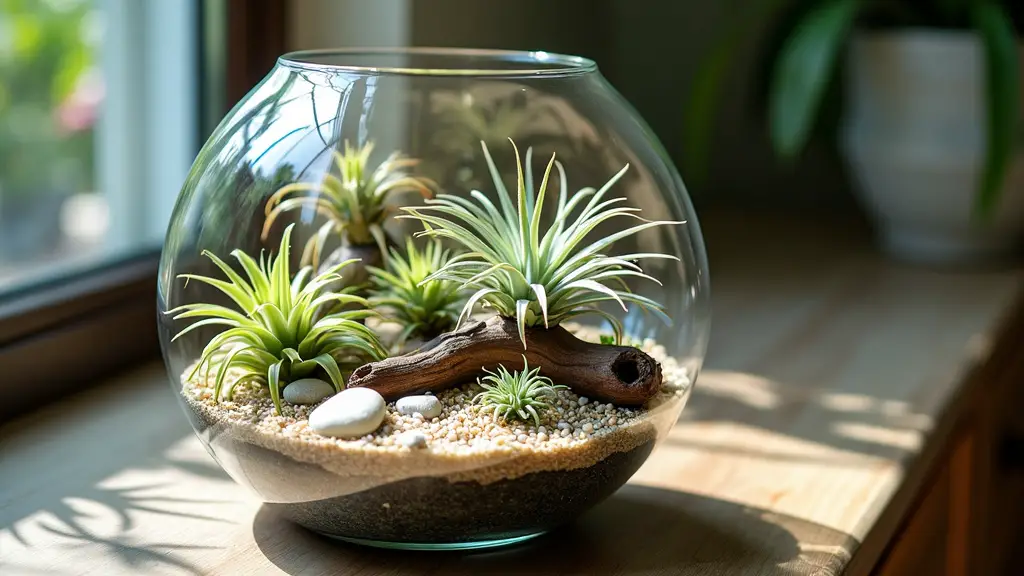
Air plants, or Tillandsia species, represent a fascinating group of plants that grow without soil. These epiphytes absorb nutrients and moisture through their leaves, making them ideal for terrariums where traditional potting methods might be challenging.
Incorporating air plants into terrariums requires careful consideration of their unique needs. While they don’t need soil, air plants benefit from occasional misting or soaking to maintain hydration. Proper air circulation prevents rot, a common issue in high-humidity environments.
Mounting techniques for air plants in terrariums vary. Options include securing them to driftwood or rocks with fishing line or specialized glue. Some gardeners prefer to let air plants rest freely on decorative elements, allowing for easy removal during watering.
Tillandsia xerographica, known for its striking silvery-green rosette, makes a bold statement in terrariums. This large air plant tolerates lower humidity levels, making it suitable for open terrariums. Its slow growth rate ensures it won’t quickly outgrow its space.
Tillandsia ionantha offers a more compact option, often developing vibrant red or pink coloration when exposed to bright light. This species multiplies readily, producing small offsets that can be separated to propagate new plants within your terrarium.
Carnivorous Plants – A Fascinating Predatory Display
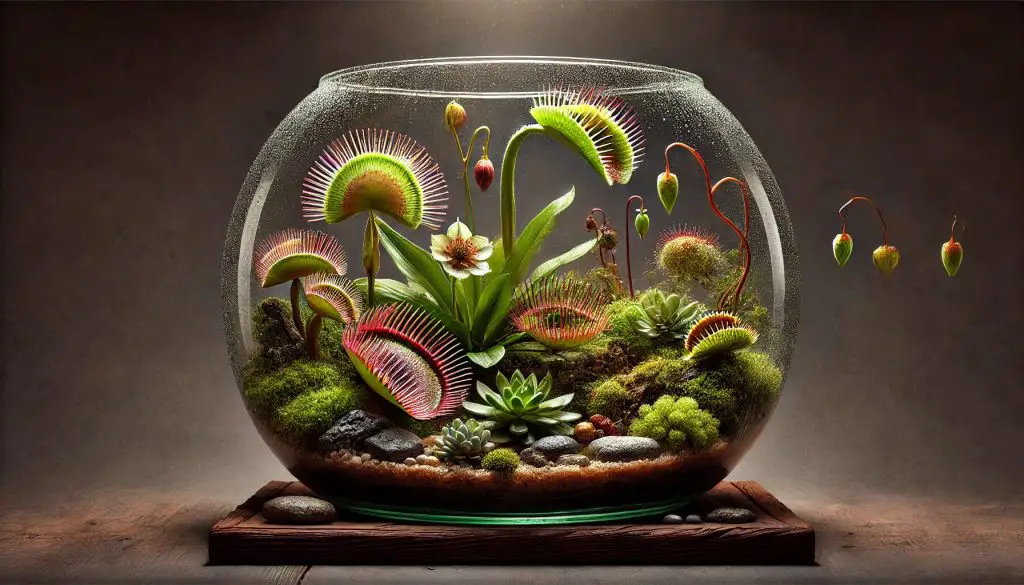
Carnivorous plants add an element of intrigue to terrariums with their ability to trap and digest insects. These plants evolved to thrive in nutrient-poor soils by supplementing their diet with prey. In terrariums, they create a dynamic and educational display.
Maintaining carnivorous plants in terrariums requires attention to their specific needs. Most species prefer high humidity and require distilled or rainwater, as minerals in tap water can harm their sensitive tissues. While they capture insects for nutrients, carnivorous plants still rely on photosynthesis for energy.
The Venus flytrap (Dionaea muscipula) stands out as one of the most recognizable carnivorous plants. Its distinctive traps snap shut when triggered by prey, creating a captivating display in terrariums. Venus flytraps require a dormancy period, so consider this when planning your terrarium design.
Sundews (Drosera species) offer a variety of shapes and sizes for terrariums. These plants feature leaves covered in sticky droplets that ensnare small insects. Compact species like Drosera adelae or Drosera spatulata work well in smaller setups.
Butterworts (Pinguicula species) provide a more subtle carnivorous option. Their rosettes of sticky leaves trap tiny insects while producing delicate flowers. Mexican butterworts, such as Pinguicula moranensis, adapt well to terrarium conditions and offer colorful blooms.
Miniature Ferns – Delicate Elegance in a Glass House
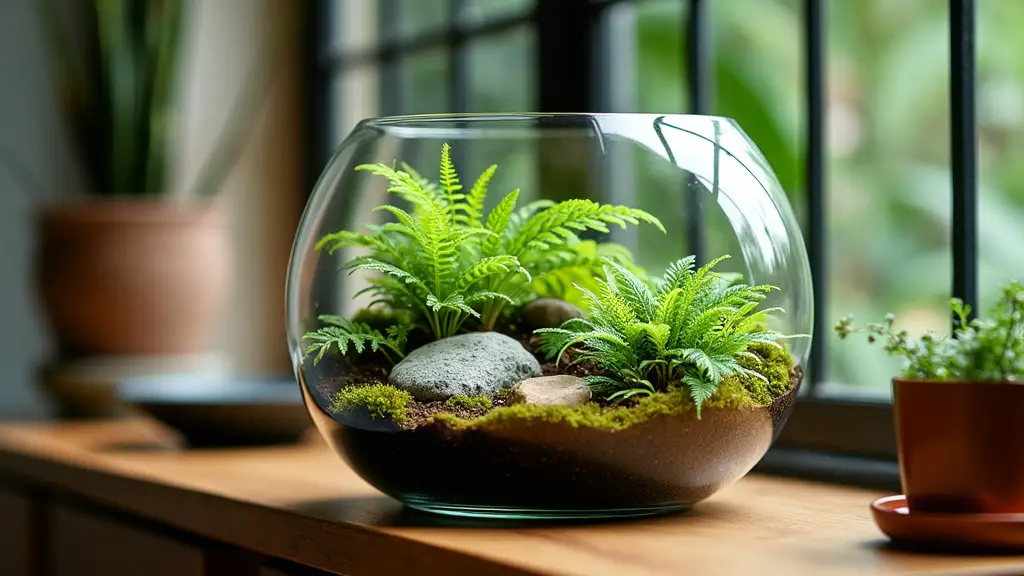
Miniature ferns bring a touch of delicate elegance to terrariums, creating lush, green landscapes in miniature. These plants thrive in the humid conditions typical of closed terrariums, making them excellent choices for low-maintenance setups.
Ferns require consistent moisture but can suffer from overwatering. Well-draining soil helps prevent root rot, a common issue in terrariums. Most fern species prefer indirect light, making them ideal for terrariums placed away from harsh sunlight.
The Button Fern (Pellaea rotundifolia) features small, round leaflets along wiry stems, creating a delicate, cascading effect. This slow-growing fern maintains a compact size, perfect for long-term terrarium displays.
Lemon Button Fern (Nephrolepis cordifolia ‘Duffii’) offers a similar compact growth habit with slightly larger, more elongated fronds. Its bright green color adds a fresh, vibrant touch to terrarium compositions.
For a unique texture, consider the Rabbit’s Foot Fern (Davallia fejeensis). This species produces furry rhizomes that creep along the terrarium surface, adding visual interest beyond its delicate fronds.
Succulents – Drought-Tolerant Jewels
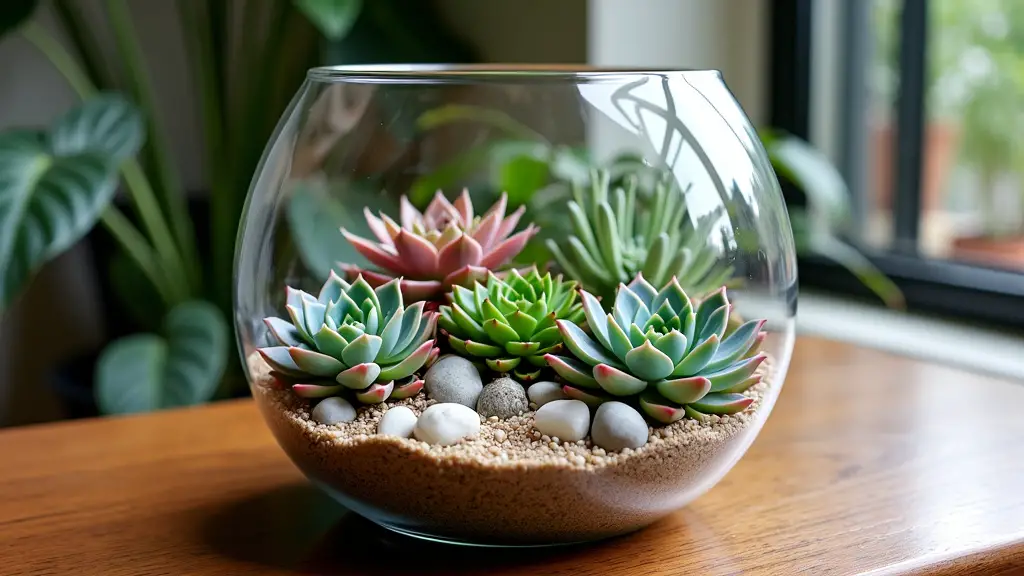
Succulents might seem counterintuitive for terrariums, given their preference for dry conditions. However, carefully selected species can thrive in well-designed open terrariums, adding unique textures and colors to your miniature landscape.
When incorporating succulents into terrariums, drainage becomes crucial. Use a substrate mix designed for cacti and succulents to prevent water retention. Place these plants in open terrariums or those with excellent air circulation to mimic their natural arid environments.
Haworthia cooperi stands out with its translucent, fleshy leaves that resemble tiny green jewels. This slow-growing succulent maintains a small size, making it ideal for long-term terrarium displays.
Lithops, often called “Living Stones,” mimic pebbles in their natural habitat. These unusual succulents consist of two fleshy leaves with a fissure between them, through which flowers emerge. Their small size and unique appearance make them fascinating terrarium subjects.
Echeveria ‘Black Prince’ offers a striking contrast with its dark, almost black rosettes. This compact succulent adds depth and drama to terrarium compositions, especially when paired with lighter-colored plants or decorative elements.
Mosses – A Lush Green Carpet
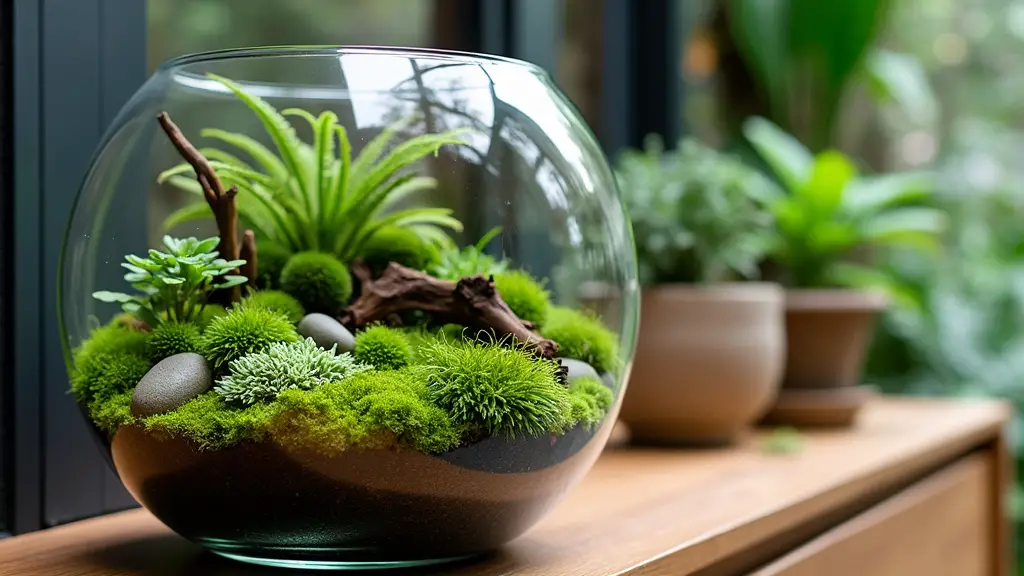
Mosses create a lush, green foundation in terrariums, mimicking forest floors in miniature. These low-growing plants thrive in the humid conditions of closed terrariums, requiring minimal care once established.
Maintaining mosses in terrariums involves keeping them consistently moist without waterlogging. Misting helps maintain humidity levels, while good air circulation prevents mold growth. Most moss species prefer indirect light, making them suitable for terrariums in various locations.
Cushion Moss (Leucobryum glaucum) forms dense, rounded clumps resembling small hills or boulders. Its pale green color adds a unique touch to terrarium landscapes, contrasting beautifully with darker plant species.
Star Moss (Tortula ruralis) offers a different texture with its compact, star-shaped growth pattern. This moss tolerates drier conditions than many others, making it suitable for open terrariums or those with varied microclimates.
For a pop of color, consider Flame Moss (Ceratodon purpureus). Under bright light, this species develops reddish tints, adding warm hues to your terrarium composition.
Orchids – Exotic Beauty in a Bottle

Orchids bring exotic beauty to terrariums, with miniature varieties perfectly suited to these enclosed environments. Many orchid species naturally grow in high-humidity environments, making them ideal candidates for closed terrariums.
Caring for orchids in terrariums requires attention to their specific needs. Most prefer high humidity but also need good air circulation to prevent fungal issues. Use orchid-specific potting media to ensure proper drainage and aeration around the roots.
The Jewel Orchid (Ludisia discolor) stands out for its striking foliage rather than its flowers. Dark leaves with contrasting veins create a beautiful backdrop in terrariums, while small white flowers provide seasonal interest.
Miniature Phalaenopsis orchids offer the classic moth orchid flowers in a compact package. These plants produce long-lasting blooms, adding color and elegance to terrarium displays for months at a time.
For a unique option, consider Pleione orchids. These small terrestrial orchids produce large, showy flowers relative to their size. Their pseudobulbs add interesting texture to terrarium compositions even when not in bloom.
Bromeliads – Tropical Flair in a Miniature Landscape

Bromeliads bring a touch of tropical flair to terrariums with their colorful foliage and unique growth habits. Many species naturally grow as epiphytes, making them well-suited to the humid conditions of closed terrariums.
When incorporating bromeliads into terrariums, consider their water storage capabilities. Most bromeliads form a central “cup” with their leaves, which holds water. In terrariums, it’s important to keep this cup filled with fresh water while ensuring the potting medium doesn’t become waterlogged.
Neoregelia ‘Fireball’ offers vibrant red coloration, especially when exposed to bright light. This compact bromeliad maintains its small size, making it perfect for long-term terrarium displays.
Cryptanthus ‘Earth Star’ presents a flatter growth habit with leaves arranged in a star-like pattern. Available in various colors, including pink, green, and bronze, these bromeliads add interesting texture and color to terrarium floors.
For vertical interest, consider Tillandsia cyanea, the Pink Quill Plant. This bromeliad produces a flattened, bright pink flower spike contrasting beautifully with its green foliage.
Dwarf Trees – Bringing the Outdoors In
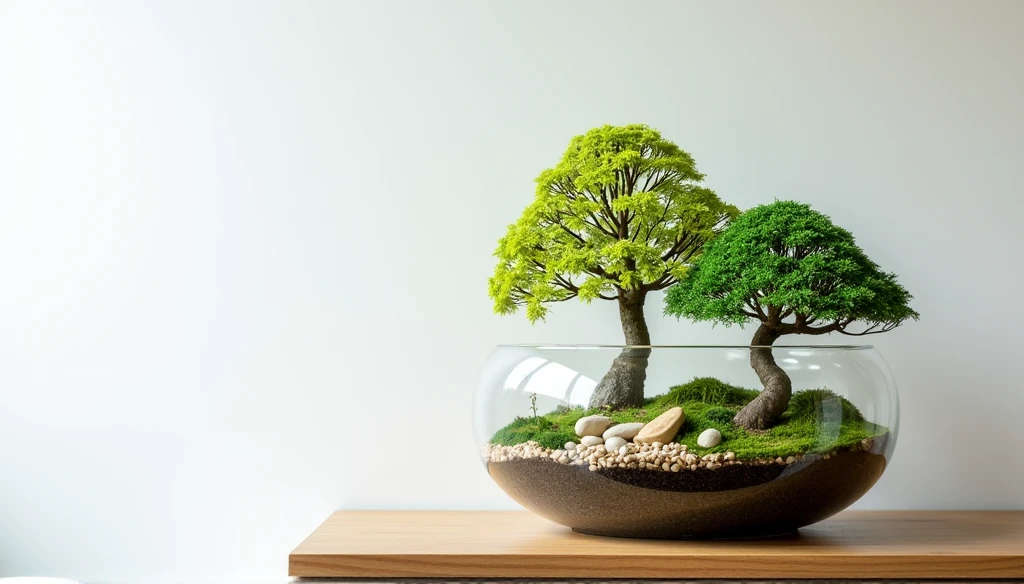
Dwarf trees create the illusion of a miniature forest within your terrarium, adding vertical interest and a sense of scale. While not typically associated with terrariums, carefully selected dwarf varieties can thrive in these enclosed environments.
Maintaining dwarf trees in terrariums requires regular pruning to control size and shape. Use a well-draining soil mix and monitor watering carefully to prevent root rot. Most dwarf trees benefit from periods of brighter light to maintain healthy growth.
The Japanese Maple (Acer palmatum) offers varieties that remain small with proper pruning. Cultivars like ‘Kiyohime’ or ‘Shaina’ provide delicate foliage that changes color with the seasons, creating dynamic terrarium displays.
Dwarf Citrus trees, such as calamondin or kumquat varieties, add both visual interest and fragrance to terrariums. These plants require more light than many terrarium species, so consider their placement carefully.
For a coniferous option, Dwarf Alberta Spruce (Picea glauca ‘Conica’) provides year-round greenery. Its compact, conical shape mimics full-sized spruce trees in miniature form.
Unusual Vining Plants – Adding a Vertical Dimension
Vining plants introduce a vertical element to terrariums, creating depth and interest as they climb and trail. These plants help maximize space in small terrariums while adding a dynamic, living element to the composition.
When incorporating vining plants, provide support structures like small trellises or natural elements like branches. Monitor growth to prevent vines from overwhelming other plants or escaping the terrarium entirely.
String of Hearts (Ceropegia woodii) features delicate, heart-shaped leaves on thin, trailing stems. This succulent vine tolerates lower humidity levels, making it suitable for open terrariums.
Hoya kerrii, known as the Sweetheart Hoya, offers thick, heart-shaped leaves and occasional clusters of star-shaped flowers. Its slow growth rate prevents it from quickly outgrowing the terrarium.
For a more unusual option, consider Peperomia prostrata, the String of Turtles. This small-leaved vine creates intricate patterns as it trails, resembling a string of tiny turtle shells.
Curating Your Unique Terrarium
As we’ve explored, unconventional plants offer endless possibilities for creating captivating terrariums. From air plants that defy traditional growing methods to carnivorous species that add an element of intrigue, each plant brings its own character to these miniature ecosystems.
Experiment with combinations of these unique plants to create terrariums that reflect your personality and spark conversation. Mix textures, colors, and growth habits to craft dynamic compositions. Remember to consider each plant’s specific needs when designing your terrarium, ensuring compatible species are grouped together.
Cultivating a terrarium filled with unconventional plants offers more than just a decorative element for your space. It provides an opportunity to observe and nurture unique species up close, deepening your connection with the natural world. As your terrarium evolves, you’ll gain insight into the delicate balance of ecosystems and the remarkable adaptations of plants.
Let your creativity guide you as you explore the world of unconventional terrarium plants. With careful selection and thoughtful care, you can create a thriving miniature landscape that brings joy and wonder to your daily life.
Practical Tips for Unconventional Terrariums
Creating terrariums with unconventional plants requires careful planning and maintenance. Here are some expert tips to help you succeed:
Choosing the Right Container
The container you select plays a crucial role in your terrarium’s success. Consider these factors:
- Size: Ensure the container is large enough to accommodate your chosen plants’ growth habits.
- Material: Glass or clear plastic allows light penetration and showcases your plants.
- Opening: Wide-mouthed containers make planting and maintenance easier.
- Drainage: For open terrariums, containers with drainage holes prevent waterlogging.
Pro tip: Repurposed items like fish bowls, cookie jars, or even light bulbs can make unique terrarium containers.
Layering for Success
Proper layering creates a foundation for healthy plant growth:
- Drainage layer: Start with a 1-2 inch layer of small pebbles or activated charcoal.
- Barrier: Add a thin layer of sphagnum moss to separate the drainage from the soil.
- Soil: Use a well-draining potting mix appropriate for your chosen plants.
- Decorative elements: Incorporate rocks, driftwood, or figurines for visual interest.
Planting Techniques
When adding plants to your terrarium:
- Root preparation: Gently loosen roots and remove excess soil before planting.
- Spacing: Allow room for growth, but group plants for a fuller appearance.
- Depth: Plant at the same depth as the original container to prevent stem rot.
Pro tip: Use long tweezers or chopsticks for precise plant placement in tight spaces.
Maintaining the Ecosystem
Once your terrarium is planted, focus on these maintenance tasks:
- Watering: Mist lightly as needed, avoiding oversaturation.
- Pruning: Regularly trim plants to maintain size and shape.
- Cleaning: Wipe the container walls to maintain visibility and remove algae.
- Fertilizing: Apply diluted, balanced fertilizer sparingly during the growing season.
Troubleshooting Common Issues
Even experienced gardeners encounter challenges with terrariums. Here’s how to address common problems:
- Mold growth: Improve air circulation and reduce watering frequency.
- Yellowing leaves: Check for overwatering or nutrient deficiencies.
- Leggy growth: Increase light exposure or prune to encourage bushier growth.
- Pest infestations: Remove affected plants and treat with neem oil or insecticidal soap.
Designing Themed Terrariums
Themed terrariums offer a creative way to showcase unconventional plants. Consider these ideas:
Miniature Desert Oasis
Create a desert scene using:
- Lithops (Living Stones)
- Haworthia cooperi
- Miniature cacti
- Sand and small rocks for the base
Design tip: Add a small ceramic animal figurine for whimsical touch.
Tropical Rainforest Floor
Mimic a lush jungle floor with:
- Miniature ferns
- Moss varieties
- Jewel orchid
- Small twigs and leaf litter for authenticity
Design tip: Incorporate a tiny waterfall feature using clear resin for added realism.
Carnivorous Plant Bog
Showcase predatory plants in a bog-inspired terrarium:
- Venus flytrap
- Sundew
- Butterwort
- Sphagnum moss and peat for the substrate
Design tip: Add a small “pond” using blue glass beads to represent water.
The Educational Value of Unconventional Terrariums
Terrariums featuring unique plants offer excellent learning opportunities:
- Biodiversity: Showcase plant adaptations to different environments.
- Ecosystem dynamics: Observe how various species interact within a confined space.
- Plant care: Learn about the specific needs of unusual plant varieties.
- Scientific observation: Monitor growth patterns and life cycles up close.
Consider creating educational labels for each plant species to enhance the learning experience.
Terrariums as Living Art
Unconventional terrariums blur the line between horticulture and art:
- Focal points: Use as eye-catching centerpieces in home or office decor.
- Living sculptures: Create three-dimensional plant arrangements that evolve over time.
- Conversation starters: Spark discussions about unique plant species and ecosystems.
- Photography subjects: Capture stunning macro images of miniature landscapes.
Artistic tip: Experiment with colored sand or glass beads to create visual contrast against green foliage.
Sustainability and Terrariums
Terrariums align well with eco-friendly gardening practices:
- Water conservation: Closed systems require minimal watering.
- Space efficiency: Grow multiple plant species in a small footprint.
- Upcycling: Repurpose glass containers for terrarium use.
- Indoor air quality: Some terrarium plants can help purify indoor air.
Eco tip: Source plants from responsible growers who prioritize sustainable cultivation methods.
Wrapping Up: Enjoying the Unconventional
Unconventional terrarium plants open up a world of possibilities for creative gardening. By thinking beyond traditional choices, you can craft miniature ecosystems that captivate, educate, and inspire. Whether you’re drawn to the alien beauty of carnivorous plants, the delicate elegance of miniature orchids, or the sculptural forms of succulents, there’s an unconventional plant perfect for your terrarium vision.
As you embark on your terrarium journey, remember that success comes through experimentation and observation. Don’t be afraid to try new combinations or techniques. Each terrarium you create becomes a unique reflection of your creativity and connection to the natural world.
The joy of cultivating unconventional terrariums extends beyond the final product. The process of researching unusual plants, designing miniature landscapes, and nurturing these tiny ecosystems offers its own rewards. You’ll gain a deeper appreciation for plant diversity and adaptability while developing new gardening skills.
So, gather your supplies, select your unconventional plants, and let your imagination run wild. The world of miniature gardening awaits, full of endless possibilities for creating your own glass-enclosed wonders. Happy terrarium crafting!
